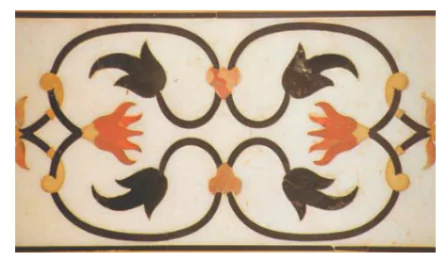Introduction
Indo-Islamic architecture started with the Ghurid occupation of India at the end of the 12 century AD. The Muslims have combined varied designs from the Sassanian and Byzantine empires, which they inherited, with the local culture, giving rise to Indo-Saracenic or Indo-Islamic architecture.They introduced new elements such as calligraphy, ornamentation using inlay work, trabeation, brackets, domes etc.
Important Features of Indo-Islamic Architecture
- Time Period: Islam arrived in India in the seventh and eighth centuries, it was brought by merchants, traders, holy men, and conquerors.
- By the 8th century CE, Islamic construction began in regions like Sindh and Gujarat.
- Large-scale building commenced in the early 13th century under the Delhi Sultanate following the Turkish conquest.
- Fusion of Architectural Styles: Muslim migrants integrated features of local Indian cultures with their own architectural practices. It resulted in a blend of structural techniques, shapes, and surface decorations, known as Indo-Saracenic or Indo-Islamic architecture.
Enroll now for UPSC Online Course
Religious Influences on Architecture
- Hindu Influence: Hindus perceived multiple forms of god everywhere.
- It resulted in structures adorned with sculptures and paintings.
- Muslim Influence: Muslims believe in one god, with Muhammad as their Prophet.
- The Islamic prohibition on depicting living forms led to the development of Arabesque (Ornamental design using intertwined flowing lines), Geometrical patterns, Calligraphy (Decorative handwriting or handwritten lettering on plaster and stone) etc.
Architecture of Indo-Islamic Structures
- Evolution: Over time, India witnessed the construction of various architectural structures catering to religious and secular needs.
- Key Structures: Included daily mosques, principal Jama Masjids, tombs, Sufi Islamic shrines known as Dargahs, tall Minars, Hammams or bathhouses, formal gardens, educational institutions called Madrasas, resting places for travellers named Sarais or Caravanserais, and roadside distance markers termed Kos Minars.
- These edifices supplemented the already existing building types in the sub-continent.
Factors determined Indo-Islamic Architecture
- Indo-Islamic Synthesis: While Indo-Islamic architecture did bear Saracenic, Persian, and Turkish influences, it was predominantly marked by Indian architectural and decorative forms.
- Diverse Influences: Factors such as the availability of materials, resource limitations, the skillset at hand, and the patrons’ aesthetic preferences heavily influenced the design.
- Cultural Blend: Notably, despite the significant role of religion in medieval India, architectural elements were borrowed liberally, showcasing a blend of cultures and traditions.
Styles of Indo-Islamic Architecture
- Indo-Islamic architecture is traditionally segmented into specific styles for a nuanced understanding.
- The Imperial Style: It Emerged during the Delhi Sultanate era.
- The Provincial Style: It is associated with regions like Mandu, Gujarat, Bengal, and Jaunpur.
- The Mughal Style: It is distinctively present in places such as Delhi, Agra, and Lahore.
- The Deccani Style: It is attributed to areas like Bijapur and Golconda.
- These categorizations allow for a clearer grasp of architectural specificities rather than placing them in fixed slots
Enroll now for UPSC Online Classes
Islamic Architectural Innovations: Arcuate Style, Minarets, and Ornate Design
- Arcuate style of architecture replaced the traditional Trabeate style of architecture.
- Introduced the use of Minars around mosques.
- Mortar: was used as a cementing agent.
- Muslims, forbidden to replicate living forms on any surface, developed their religious art and architecture, consisting of the arts of Arabesque, geometrical patterns and calligraphy on plaster and stone
- Arabesque: An ornamental design consisting of intertwined flowing lines, leaves and flowers
- The buildings had intricate jaali works, which signifies the importance of light in the Islamic region.
- The use of water in the courtyard pools, fountains and small drains gained importance.
- Water was used primarily for three purposes, i.e. Religious, Decorative, and to cool the premises.
 They introduced the ‘Charbagh style’ of garden, in which a square block was divided into four identical gardens.
They introduced the ‘Charbagh style’ of garden, in which a square block was divided into four identical gardens.- Pietra-dura Technique: refers to the pictorial mosaic work using semi-precious stones.
- Tessellation: A technique for the decoration of walls and floors with mosaic.
- Foreshortening Technique: which makes the inscriptions appear closer than they really are.
Difference Between Arcuate Style And Trabeate Style
| ARCUATE STYLE |
TRABEATE STYLE |
- Use of arches and domes.
- Arches needed to be constructed with voussoirs (series of interlocking blocks), fitted with keystones.
- Use of hemispherical domes on the top of the mosques.
- Minars were present on the four corners of the mosques.
- Lime plaster, Brick and Mortar were used for the construction.
|
- Use of brackets, pillars and lintels.
- Use of conical or curvilinear shikhara on the top of the temples.
- Minars were absent.
- Stone was the primary component of all constructions.
|
Conclusion
- Indo-Islamic architecture, a fusion of Indian and Islamic architectural styles, emerged prominently during the medieval period, reflecting the socio-political and cultural amalgamation of the two distinct civilizations.
![]() June 7, 2024
June 7, 2024
![]() 5773
5773
![]() 0
0
 They introduced the ‘Charbagh style’ of garden, in which a square block was divided into four identical gardens.
They introduced the ‘Charbagh style’ of garden, in which a square block was divided into four identical gardens.